Abstract
New techniques have been developed for the electrophysiological assessment of patients with suspected cauda equina lesions using transcutaneous spinal stimulation (500-1500 V: time constant 50 microseconds) to measure motor latencies to the external and sphincter and puborectalis muscles from L1 and L4 vertebral levels. These latencies represent motor conduction in the S3 and S4 motor roots of the cauda equina between these levels. Similarly motor latencies can be recorded from spinal stimulation to the anterior tibial muscles (L4 and L5 motor roots). Transrectal stimulation of the pudendal nerves is used to measure the pudendal nerve terminal motor latency. In 32 control subjects, matched for age and sex, mean motor latencies from L1 and L4 spinal stimulation were 5.5 +/- 0.4 ms and 4.4 +/- 0.4 ms (mean + SD). In the 10 patients with cauda equina disease including ependymoma, spinal stenosis, arachnoiditis and trauma, these latencies were 7.2 +/- 0.8 ms and 4.6 +/- 0.9 ms, a significant increase in the L1 latency. The L1/L4 latency ratios to the puborectalis muscle were 1.36 +/- 0.09 in control subjects and 1.72 +/- 0.13 in cauda equina patients. Pudendal nerve terminal motor latencies were normal in eight of the 10 patients with cauda equina disease. The single fibre EMG fibre density in the external and sphincter muscle (normal, 1.5 +/- 0.16) was increased in patients with cauda equina lesions (1.73 +/- 0.28), but was increased more than two standard deviations from the mean only in three patients. This increase in fibre density was not of diagnostic value since it was also found in two of the four patients with low back pain. Slowing of motor conduction in the cauda equina is thus a useful indication of damage to these intraspinal motor roots. These investigations can be used in the selection of patients for myelography, and to follow progress in patients managed conservatively.
Full text
PDF








Images in this article
Selected References
These references are in PubMed. This may not be the complete list of references from this article.
- Beersiek F., Parks A. G., Swash M. Pathogenesis of ano-rectal incontinence. A histometric study of the anal sphincter musculature. J Neurol Sci. 1979 Jun;42(1):111–127. doi: 10.1016/0022-510x(79)90156-4. [DOI] [PubMed] [Google Scholar]
- Desmedt J. E., Cheron G. Spinal and far-field components of human somatosensory evoked potentials to posterior tibial nerve stimulation analysed with oesophageal derivations and non-cephalic reference recording. Electroencephalogr Clin Neurophysiol. 1983 Dec;56(6):635–651. doi: 10.1016/0013-4694(83)90031-7. [DOI] [PubMed] [Google Scholar]
- Joffe R., Appleby A., Arjona V. "Intermittent ischaemia" of the cauda equina due to stenosis of the lumbar canal. J Neurol Neurosurg Psychiatry. 1966 Aug;29(4):315–318. doi: 10.1136/jnnp.29.4.315. [DOI] [PMC free article] [PubMed] [Google Scholar]
- Kiff E. S., Swash M. Normal proximal and delayed distal conduction in the pudendal nerves of patients with idiopathic (neurogenic) faecal incontinence. J Neurol Neurosurg Psychiatry. 1984 Aug;47(8):820–823. doi: 10.1136/jnnp.47.8.820. [DOI] [PMC free article] [PubMed] [Google Scholar]
- Kiff E. S., Swash M. Slowed conduction in the pudendal nerves in idiopathic (neurogenic) faecal incontinence. Br J Surg. 1984 Aug;71(8):614–616. doi: 10.1002/bjs.1800710817. [DOI] [PubMed] [Google Scholar]
- Merton P. A., Morton H. B. Stimulation of the cerebral cortex in the intact human subject. Nature. 1980 May 22;285(5762):227–227. doi: 10.1038/285227a0. [DOI] [PubMed] [Google Scholar]
- Neill M. E., Parks A. G., Swash M. Physiological studies of the anal sphincter musculature in faecal incontinence and rectal prolapse. Br J Surg. 1981 Aug;68(8):531–536. doi: 10.1002/bjs.1800680804. [DOI] [PubMed] [Google Scholar]
- Neill M. E., Swash M. Increased motor unit fibre density in the external anal sphincter muscle in ano-rectal incontinence: a single fibre EMG study. J Neurol Neurosurg Psychiatry. 1980 Apr;43(4):343–347. doi: 10.1136/jnnp.43.4.343. [DOI] [PMC free article] [PubMed] [Google Scholar]
- Parks A. G. Royal Society of Medicine, Section of Proctology; Meeting 27 November 1974. President's Address. Anorectal incontinence. Proc R Soc Med. 1975 Nov;68(11):681–690. doi: 10.1177/003591577506801105. [DOI] [PMC free article] [PubMed] [Google Scholar]
- Parks A. G., Swash M., Urich H. Sphincter denervation in anorectal incontinence and rectal prolapse. Gut. 1977 Aug;18(8):656–665. doi: 10.1136/gut.18.8.656. [DOI] [PMC free article] [PubMed] [Google Scholar]
- Percy J. P., Neill M. E., Swash M., Parks A. G. Electrophysiological study of motor nerve supply of pelvic floor. Lancet. 1981 Jan 3;1(8210):16–17. doi: 10.1016/s0140-6736(81)90117-3. [DOI] [PubMed] [Google Scholar]
- Snooks S. J., Badenoch D. F., Tiptaft R. C., Swash M. Perineal nerve damage in genuine stress urinary incontinence. An electrophysiological study. Br J Urol. 1985 Aug;57(4):422–426. doi: 10.1111/j.1464-410x.1985.tb06302.x. [DOI] [PubMed] [Google Scholar]
- Snooks S. J., Barnes P. R., Swash M. Damage to the innervation of the voluntary anal and periurethral sphincter musculature in incontinence: an electrophysiological study. J Neurol Neurosurg Psychiatry. 1984 Dec;47(12):1269–1273. doi: 10.1136/jnnp.47.12.1269. [DOI] [PMC free article] [PubMed] [Google Scholar]
- Snooks S. J., Henry M. M., Swash M. Anorectal incontinence and rectal prolapse: differential assessment of the innervation to puborectalis and external anal sphincter muscles. Gut. 1985 May;26(5):470–476. doi: 10.1136/gut.26.5.470. [DOI] [PMC free article] [PubMed] [Google Scholar]
- Snooks S. J., Swash M. Abnormalities of the innervation of the urethral striated sphincter musculature in incontinence. Br J Urol. 1984 Aug;56(4):401–405. doi: 10.1111/j.1464-410x.1984.tb05830.x. [DOI] [PubMed] [Google Scholar]
- Snooks S. J., Swash M. Perineal nerve and transcutaneous spinal stimulation: new methods for investigation of the urethral striated sphincter musculature. Br J Urol. 1984 Aug;56(4):406–409. doi: 10.1111/j.1464-410x.1984.tb05831.x. [DOI] [PubMed] [Google Scholar]
- Thornton J. R. High colonic pH promotes colorectal cancer. Lancet. 1981 May 16;1(8229):1081–1083. doi: 10.1016/s0140-6736(81)92244-3. [DOI] [PubMed] [Google Scholar]





